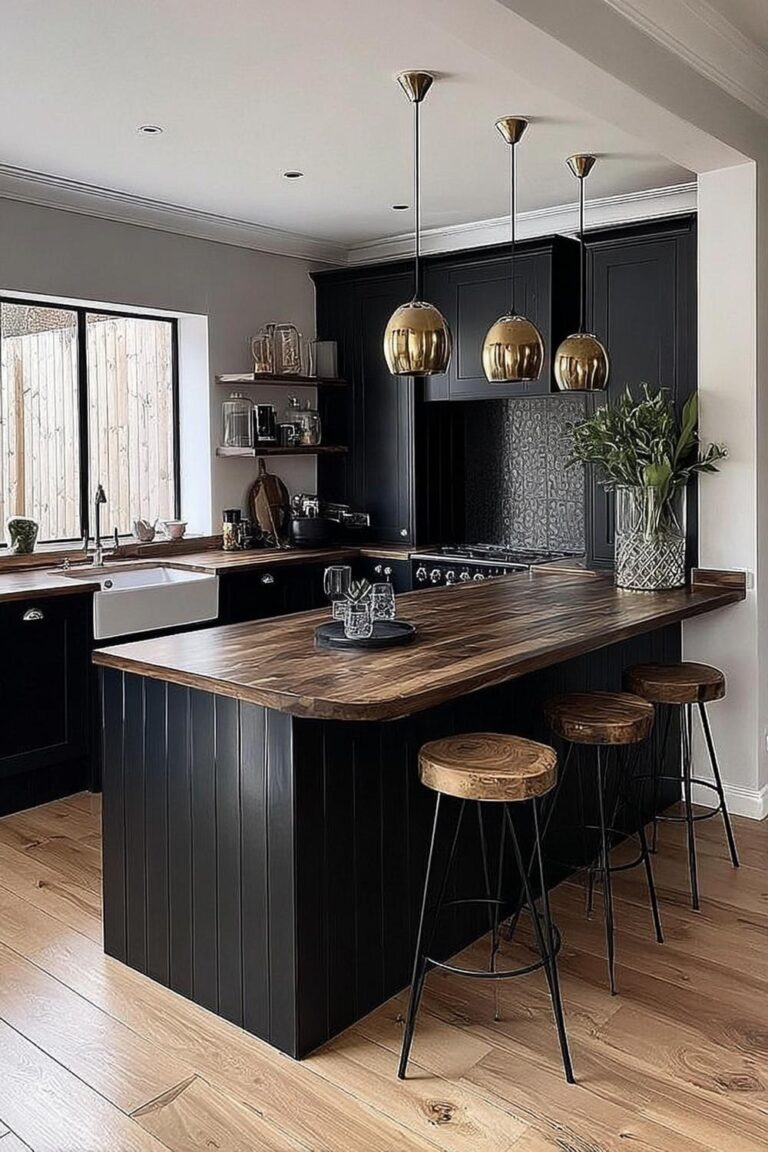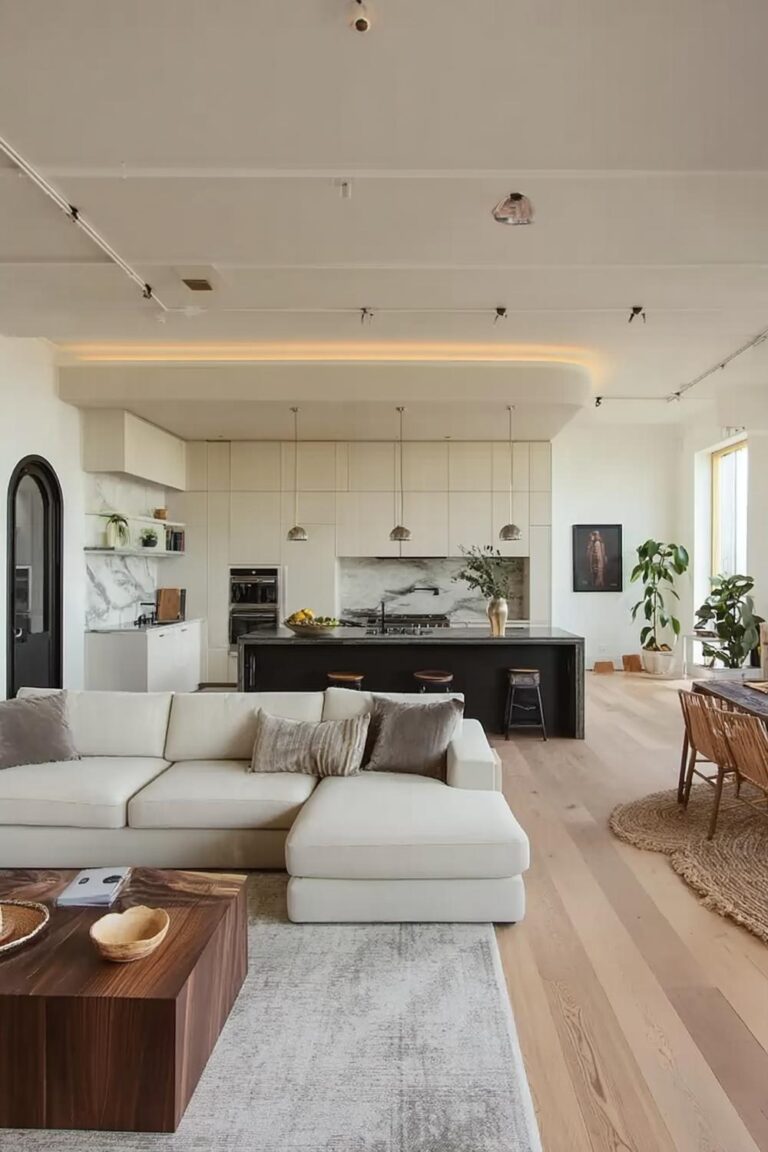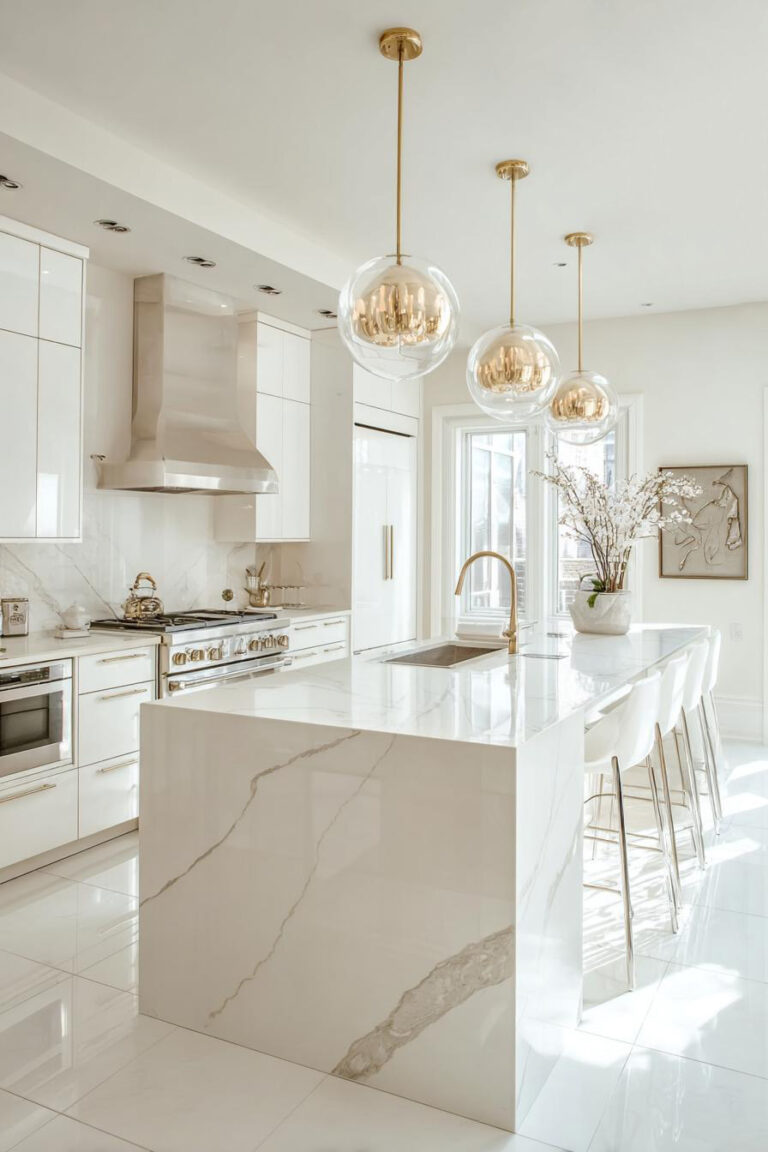Small kitchens challenge you to think differently about space. Every square inch counts when your cooking zone barely fits two people side by side.
Yet these compact spaces spark incredible creativity. You’ll discover that limitations often lead to the most ingenious solutions – from hidden storage tricks to multifunctional furniture that transforms your miniature culinary corner into something unexpectedly delightful.
1. Create Visual Interest Using Natural Wood Shelves in Modern Kitchen

Like branches reaching across a forest canopy, natural wood shelves bring organic movement to sterile kitchen walls. The grain patterns create visual stories that draw your eye upward, making cramped quarters feel less confining.
Picture this: reclaimed oak planks floating against white subway tiles, holding your favorite mugs and that collection of vintage spice jars you inherited from your grandmother. The warmth of wood softens harsh angles while providing essential storage – it seems the Scandinavians were onto something when they pioneered this look decades ago.
Start with just two shelves near your prep area. You can always add more as you discover what works for your daily routines.
2. Integrate Under Cabinet Lighting to Brighten Mini Kitchen Workspace

Who decided overhead lighting alone was enough? Clearly someone who never tried to chop onions in their own shadow.
Under-cabinet LED strips emerged as the go-to solution when apartment dwellers started documenting their cooking adventures on social media around 2015.
These slim fixtures – often no thicker than a pencil – tuck discreetly beneath upper cabinets, casting light exactly where you need it while creating an almost floating effect that visually expands your workspace.
3. Use String Lights Behind Sheer Curtains For Cozy Ambiance

Your kitchen feels cold and unwelcoming after dark, but installing new fixtures seems overwhelming. String lights offer an instant fix that transforms harsh spaces into inviting retreats.
Watch how warm white bulbs behind gauze-like fabric create a dreamy glow that softens edges and hides imperfections. The effect mimics candlelight without fire hazards – particularly appealing when your smoke detector sits just feet away from your stovetop.
Try battery-operated versions first. You’ll avoid electrical work while testing different arrangements.
4. Add Practicality with Fold Down Wooden Counter in Mini Kitchen
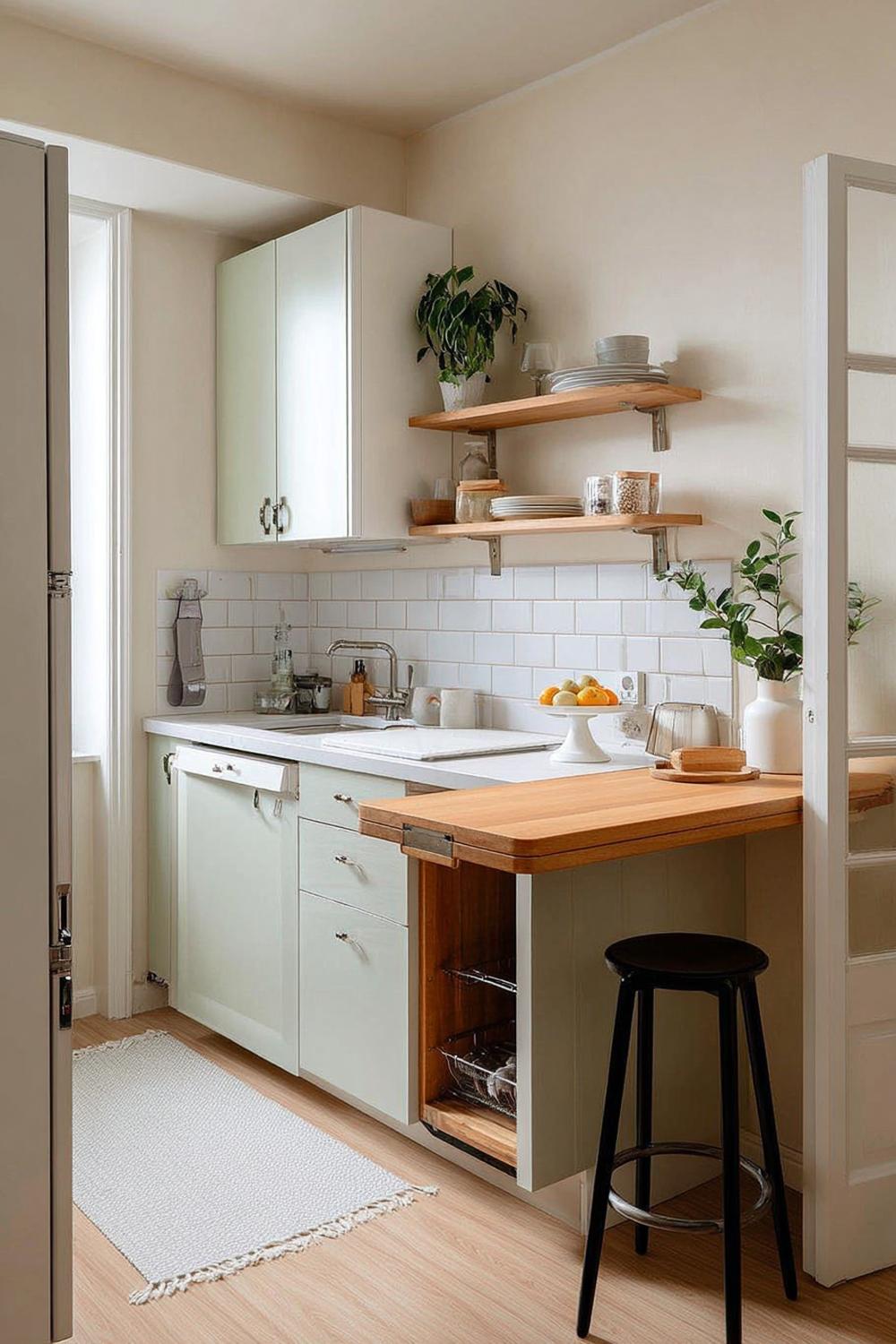
The tiny house movement taught us that furniture should work harder than we do. Fold-down counters epitomize this philosophy, appearing when needed and vanishing when not.
Consider Sarah’s Brooklyn studio: her wall-mounted bamboo counter serves as morning coffee station, afternoon workspace, and evening bar for two. When folded up, it becomes an art piece – the wood grain providing texture against painted walls.
This single addition multiplies your usable surface area without stealing precious floor space.
5. Highlight Contrast with Black Pendant Lighting and Stools

Choose black fixtures against light backgrounds. The drama they create makes everything else pop with unexpected energy.
Matte black pendants hovering above a white counter create focal points that guide eyes through your space. Add matching bar stools, and suddenly your tiny breakfast nook commands attention like a downtown bistro. The dark elements ground floating shelves and light cabinets, preventing that washed-out look that plagues many small kitchens.
Just remember – black shows every fingerprint and water spot. You’ll be wiping down surfaces more often than you’d prefer.
6. Optimize Wall Space with Open Shelves For Scandinavian Kitchen
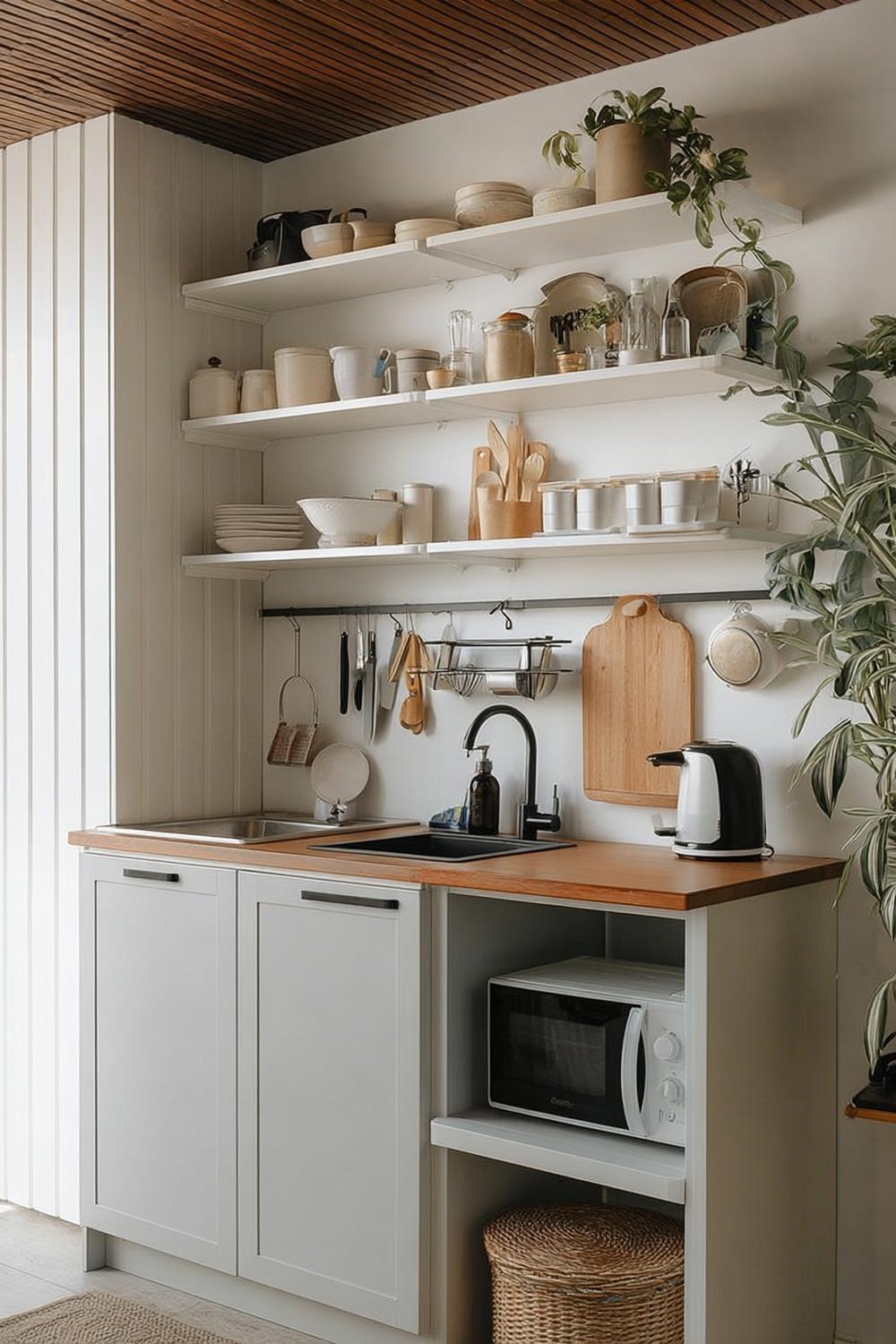
Three key elements define this approach: white walls, blonde wood, and absolutely nothing hidden. Every dish, cup, and cutting board becomes part of your décor.
Open shelving forces you to curate your kitchenware carefully. Those mismatched plates from college? They’ll need replacing with cohesive pieces that look intentional when displayed. Yet this constraint brings unexpected freedom – reaching for items becomes effortless, and washing dishes feels less tedious when everything has its visible place.
Could you live with your kitchen goods on permanent display, or would the visual clutter eventually overwhelm you?
7. Incorporate Patterned Tile Backsplash For Rustic Charm

That stretch of wall between counter and cabinets often gets overlooked – just another surface to wipe clean. Patterned tiles transform this forgotten zone into your kitchen’s main character.
Moroccan-inspired geometrics or Portuguese azulejos bring movement and color without overwhelming tight quarters. The repetitive patterns create rhythm that guides your eye horizontally, stretching perceived space while protecting walls from splashes and steam.
Speaking of protection, these tiles also hide the inevitable wear that comes with daily cooking, making them perfect as you transition into our next space-saving solution.
8. Enhance Functionality with a Compact Breakfast Table and Stools

You might think dining tables belong in dining rooms, but compact versions earn their keep in tiny kitchens. These pieces serve triple duty as prep space, eating area, and social hub.
Round tables work particularly well – no sharp corners means smoother traffic flow when you’re navigating with hot pans. Backless stools tuck completely underneath, disappearing when not needed. Some tables even feature built-in storage beneath, housing items you use occasionally but can’t quite part with (looking at you, waffle maker).
As urban living continues shrinking square footage, expect to see more innovative table designs that fold, extend, or transform based on immediate needs.
9. Bring Warmth with Natural Wood Furniture and Flooring
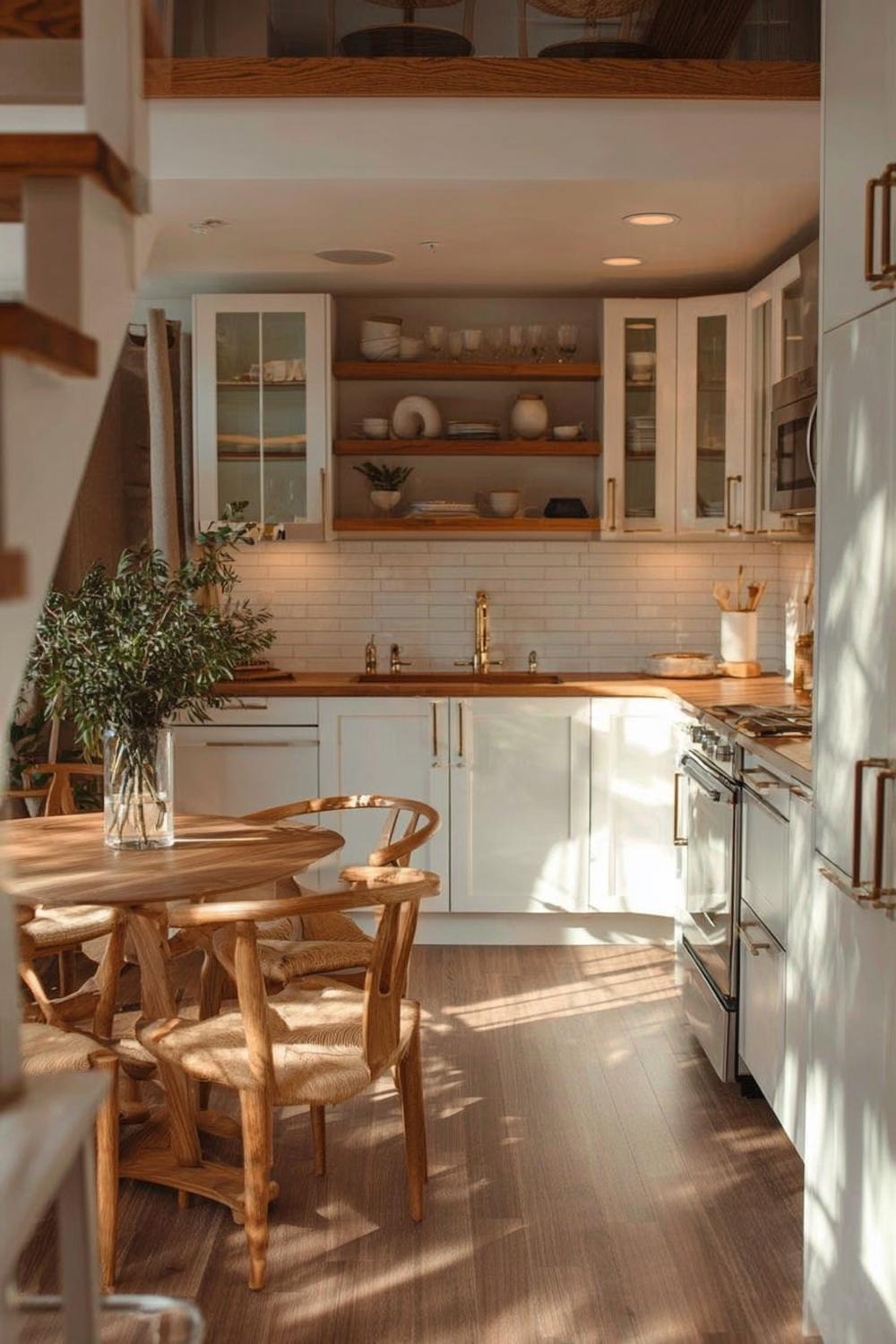
Trees take decades to grow their distinctive grain patterns – each ring marking another year of sun, rain, and seasons passing. Bringing this natural history into your kitchen adds depth that manufactured materials can’t replicate.
Honey-toned oak floors paired with walnut cabinets create layers of warmth that make winter mornings more bearable. The wood’s texture provides visual interest without busy patterns, while its natural variation prevents that too-perfect look that feels staged rather than lived-in.
I’ve noticed kitchens with wood elements tend to age gracefully – scratches and water marks adding character rather than detracting from appearance.
This organic approach influences how you use the space. You’ll find yourself lingering longer, perhaps drinking that second cup of coffee while sunlight highlights the grain patterns you hadn’t noticed before.
10. Elevate Style with Industrial Track Lighting in Mini Kitchen
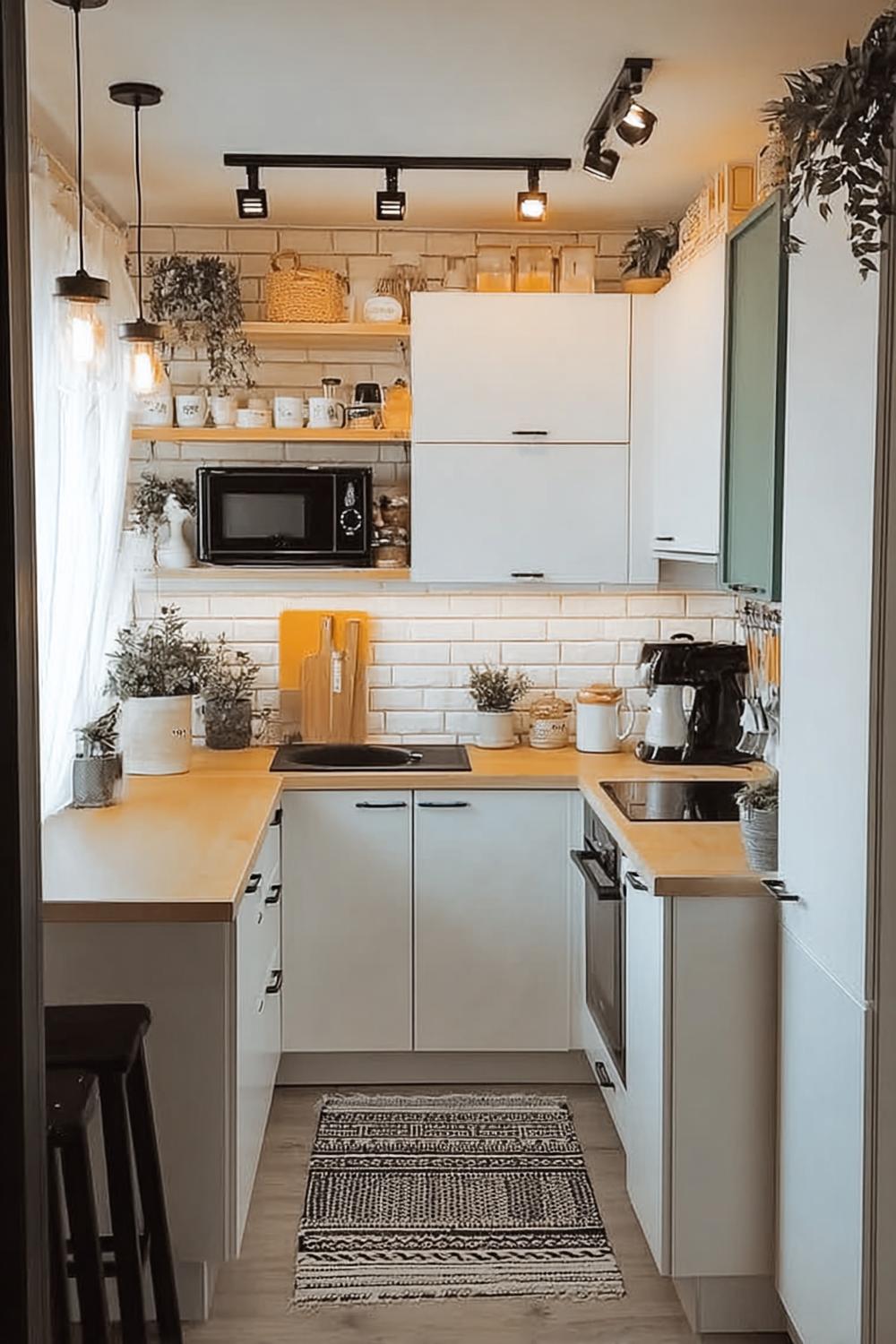
Forget everything you know about kitchen lighting – track systems shatter conventional rules. These adjustable fixtures bring gallery-style drama to the smallest spaces.
Picture exposed Edison bulbs on black metal tracks, each light positioned to highlight specific zones: one illuminates your cutting board, another spotlights open shelving, a third creates ambiance over your tiny dining spot.
My friend renovated her galley kitchen with copper tracks that snake across the ceiling like modern art – guests always comment on them first.
The beauty lies in flexibility; you can redirect lights seasonally, adjust for tasks, or create entirely different moods by dimming certain bulbs while brightening others.
11. Frame Scenic Views with Large Wooden Window in Apartment
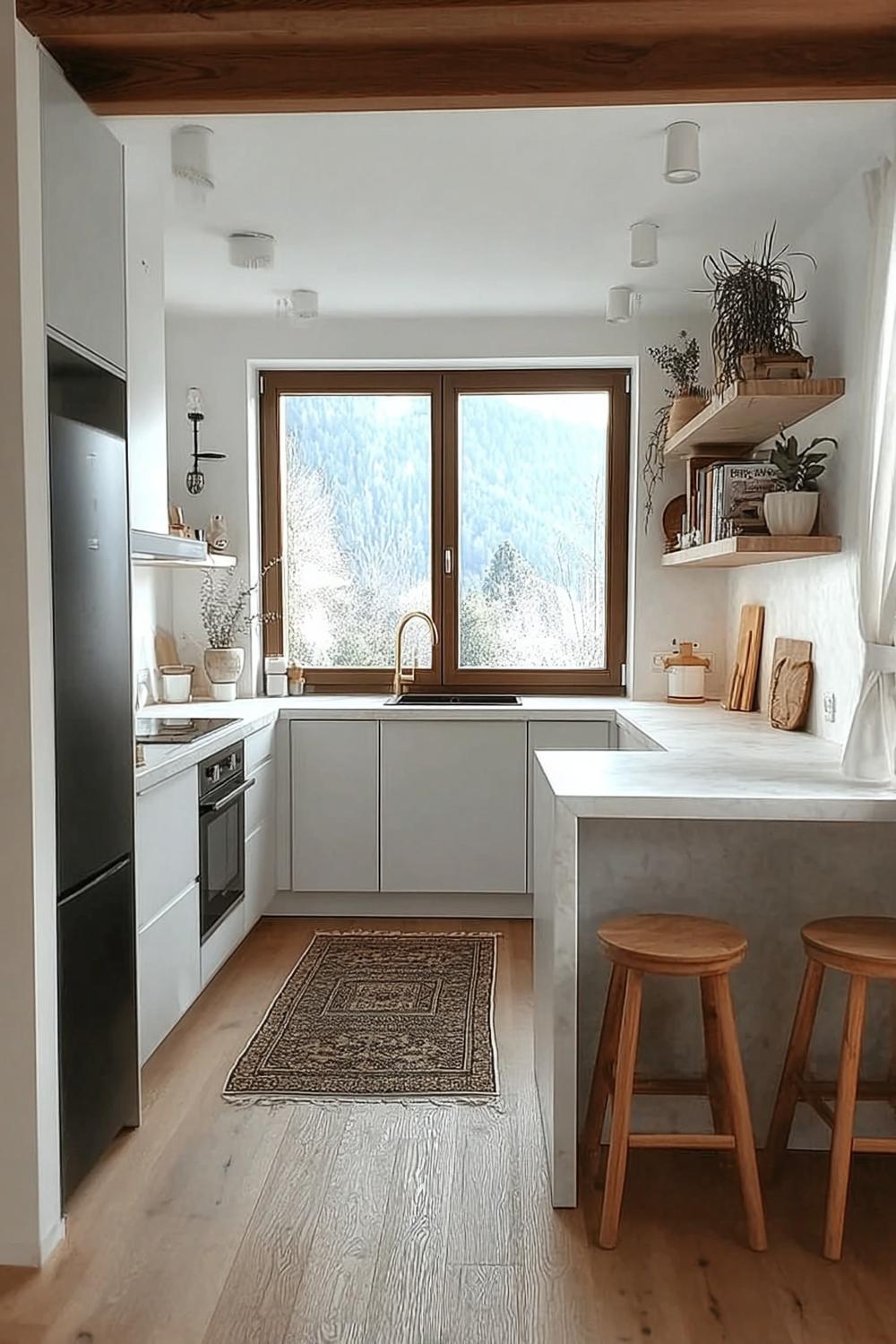
A generous window transforms any tiny kitchen into something extraordinary. Natural light costs nothing yet adds immeasurable value to cramped quarters.
When blessed with decent views – even just neighboring rooftops or a single tree – that window becomes your kitchen’s centerpiece. Morning light streaming through wooden frames creates shadows that shift throughout the day, providing free entertainment while you cook.
The outside world, whether bustling city or quiet courtyard, extends your visual space beyond physical walls.
Natural wood frames connect interior and exterior, making your tiny kitchen feel part of something larger.
12. Highlight Kitchen Warmth with Wood Countertops and Ceiling in Farmhouse
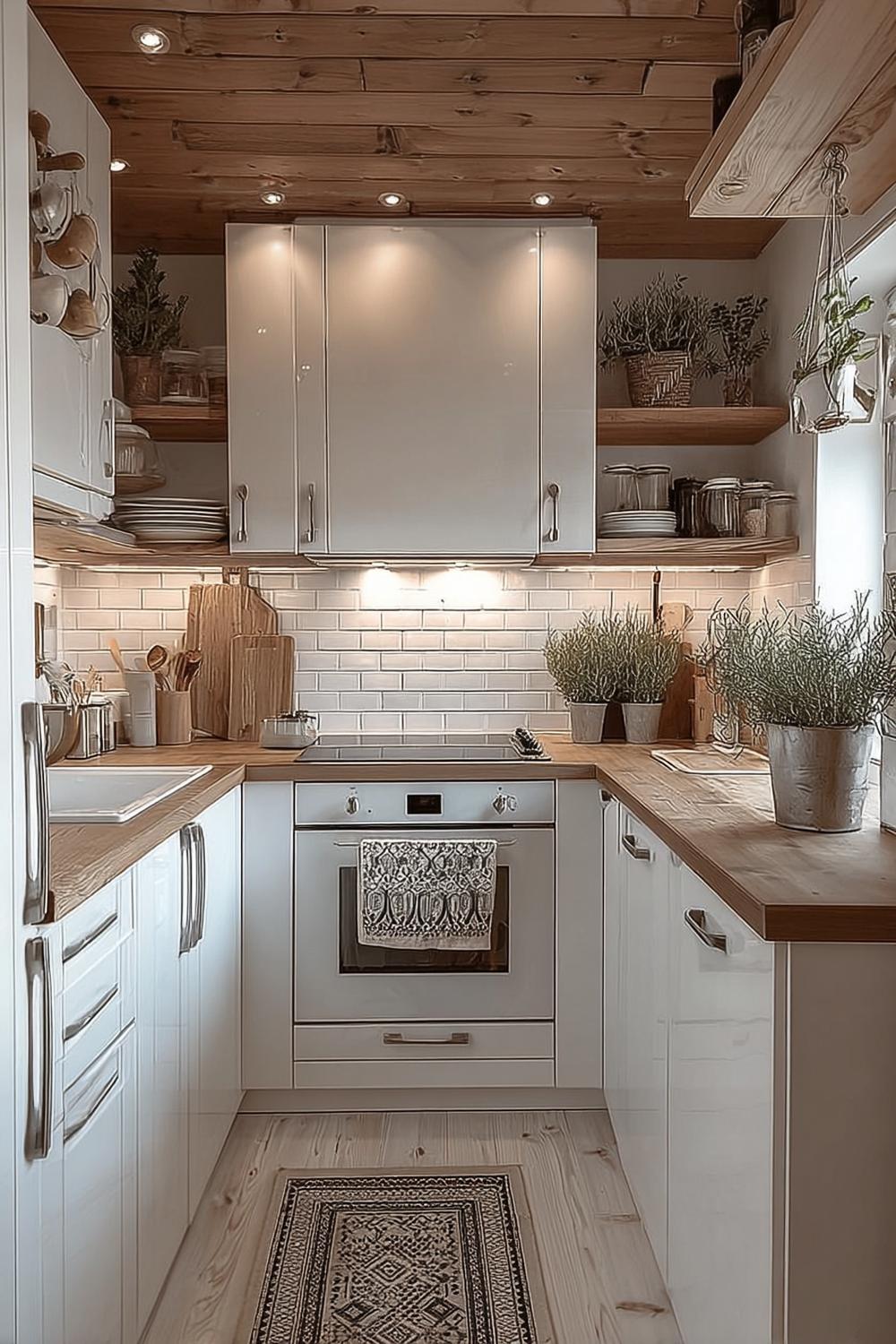
Unlike granite’s cold perfection, wood counters invite touch – they’re surfaces that improve with age and use. Overhead, exposed beams or planked ceilings cocoon you in warmth, creating that farmhouse feeling even in city apartments.
The combination wraps your kitchen in natural texture that changes with light and season. Morning sun brings out golden undertones, while evening shadows deepen the grain patterns. You’ll notice how wood dampens sound too – conversations feel more intimate, less echo-prone than in stark modern kitchens.
Be prepared though: wood demands attention. Without proper sealing and regular maintenance, those beautiful counters will show every water ring and knife mark within months.
13. Maximize Storage with Wall Mounted Metal Shelves in Mini Kitchen

While everyone obsesses over hidden storage, exposed metal shelving makes a bold statement: yes, this kitchen is small, and we’re not apologizing for it. Industrial-style brackets and mesh shelves turn storage into architecture.
These systems emerged from restaurant kitchens where efficiency trumps aesthetics – or rather, efficiency became the aesthetic. Stainless steel or powder-coated options resist moisture and heat better than wood, making them particularly suited for areas near stoves or sinks.
The open design keeps everything visible and accessible, forcing you to maintain order.
Position heavier items on lower shelves and frequently used pieces at eye level – your back will thank you later.
14. Use a Fold Down Wooden Table with Bar Stools For Mini Kitchen

Why dedicate precious space to a table you use twice daily? Modern fold-down designs challenge this assumption brilliantly.
Wall-mounted tables now come with gas pistons for smooth operation – no more wrestling with heavy leaves or unstable hinges. Combined with stools that stack or hang nearby, you’ve created a dining solution that practically disappears between meals.
The wooden surface could double as additional counter space when half-lowered, giving you flexibility traditional tables never could.
Test the mechanism thoroughly before installing. Once mounted, these tables are difficult to reposition if heights don’t align with your needs.
Conclusion
Your tiny kitchen holds more potential than those cramped quarters suggest. Each idea here – from floating wood shelves to fold-down tables – proves that size constraints spark innovation rather than limiting it.
Start with one change that excites you most. Maybe it’s string lights for instant ambiance or industrial shelving that celebrates your space’s compact nature. Once you experience how a single thoughtful addition transforms daily cooking routines, you’ll understand why tiny kitchens often become the most beloved rooms in a home.

